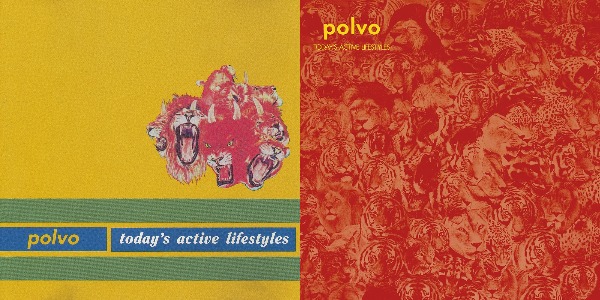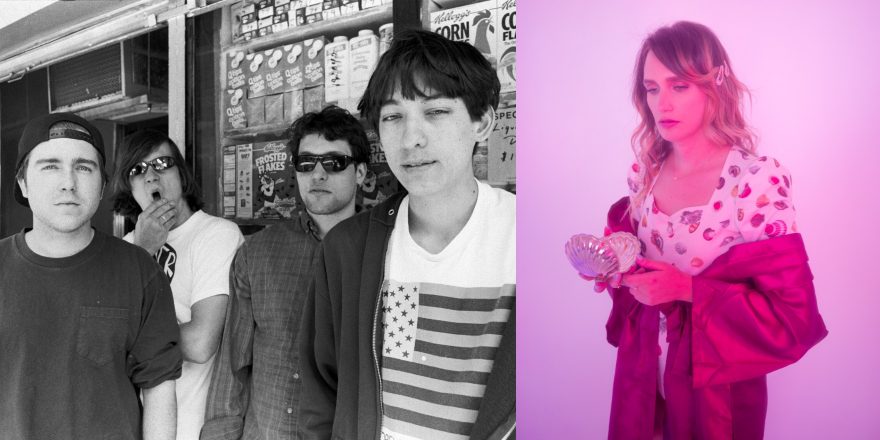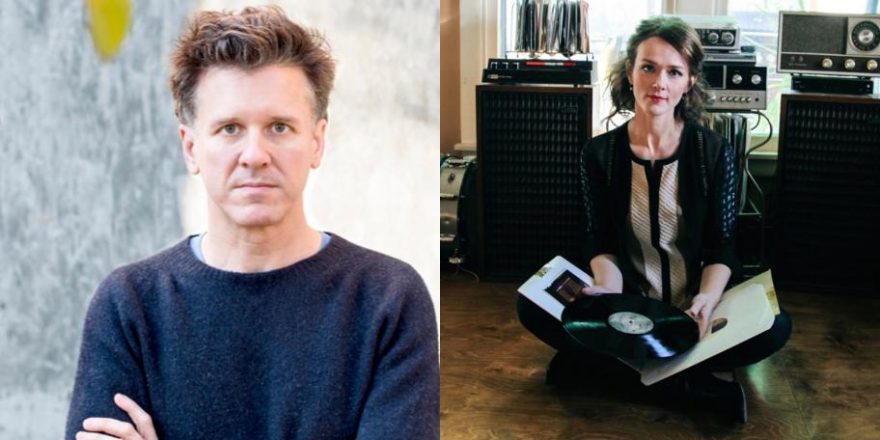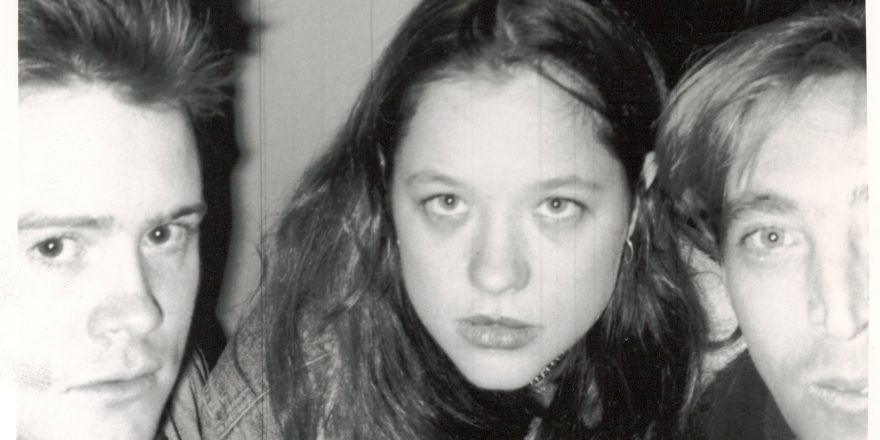It’s totally baffling listening to Polvo’s members — groundbreaking heros to my buddy circle of indie rock players — insist they have no legacy. Chatting over the phone with bassist Steve Popson and guitarist/singer Ash Bowie, I’m tempted to rattle off contemporary bands I’m sure ripped Polvo off, or at least tried — on the record, mine included. Late night post-interview tweeting turned up a chorus of other Polvo-inspired musicians, and led me to a pretty wonderful “My Kimono” sample in a 2018 bedroom pop banger. Whether they admit it or not, Polvo’s influence has indeed stretched into the 21st century.
The Chapel Hill quartet, squared out by guitarist/singer Dave Brylawski and original drummer Eddie Watkins (who sadly passed away in 2016), made beguiling, absorbing albums — the first two of which see reissue this month on Merge Records. Cor-Crane Secret (1992) and Today’s Active Lifestyles (1993) showcased forward-thinking, slack-tuned guitar work that set a high bar for subsequent post- and math rock projects, the latter of which is a genre characterization the band disavows (although take that with a grain of salt — as you’ll see, disavowal is kind of their thing). On these recordings, I hear futuristic leaps over retrograde rhythms, discrete melodic lines colliding and recollecting together, pop songs translated from an alien scale into cathartic human rock. But when I describe their music to them in these woo-woo terms, Ash and Steve tell me their songs are fairly normal. Their unwavering pragmatism feels unusual for a band on the cusp of that aforementioned reissue.
Though its members don’t relish talking about their old records, Polvo is exceptionally nice to me (who is, it bears repeating, a fanboy). After the interview, Steve sends me a dapper high school yearbook photo of his label head, Superchunk’s Mac McCaughan, then offers to mail over an old Exploded Drawing t-shirt (a Polvo album about which Ash admits, with that same self-deprecation: “I didn’t think we were having a good time in that studio, but we did it,” then conceding that “people like that record.”) Ash lights up describing a Jesus Lizard/Polvo/Tar show at CBGB, and watching from a hiding place as Steve, front and center in the audience, held back a whole wall of people from the stage.
Even if they’re too modest to self-congratulate, it’s touching listening to them acknowledge each other’s work. If by some freak accident someone asks me about one of my records in 30 years, I’d be lucky to have a buddy around to say, “Hey, actually, I think you did a great job there,” which is exactly what Steve and Ash provide for each other in this conversation.
— Sadie Dupuis
Ash Bowie: I’ll preface this by saying we’re old now — if you ask a lot of details about 1990, we’re in trouble.
Sadie Dupuis: I can hardly remember things I recorded six months ago. I think you’re heroes for chatting about records just shy of 30 years old. Speaking of: why 2020 to reissue these?
Steve Popson: The whole reissue thing was Merge’s idea. So we were like, “Sounds great.”
Ash: I think Dave [Brylawski] was like, “What’s the point?” [Laughs.] But once we started working on the artwork and looking at old pictures and stuff, he got into it. That part was fun.
Sadie: Steve, you were a club owner in Raleigh, and I know you guys both get out to local shows — can you see a legacy of your influence in either contemporary rock or your own scene? And does reissuing these feel important for that reason?
Steve: In my heyday [owning] Kings, the time that I was really, really, really most involved, which is like ’99 through the aughts, was an era, at least locally and I think nationally… of not aggressive rock, but less experimental. Like the Fireballs of Freedom, and all these other kind of rock & roll bands, if that makes sense? Really intense, big live shows.
And so whatever legacy or influence Polvo may have had — I didn’t really see it. We were just a band, one of a thousand really good bands at that time, that played shows. We were stoked that people actually liked listening to what we did. It still is shocking to me 30 years later. The reissue, I have no idea if it’s 40-year-old people, 50-year-old people restocking this stuff. Or if there are 18-year-old people out there buying it. I’d be shocked if it’s the latter. But I just don’t know. What do you think, Ash?
Ash: Yeah, it’s been so long since I’ve felt like I had my finger anywhere near the pulse of what people were doing that I couldn’t say. But I never really felt there was any legacy or an era. We did our thing and we were part of a zeitgeist of a certain time and place. We weren’t existing in a bubble by any means, but gosh, I don’t know. It’s hard to talk about music today because… well, we’re not out there involved in it.
Sadie: I pulled out my old LP of Cor-Crane Secret and realized you list the tracking dates on the back, and it’s just four days.
Steve: I thought it was three-and-a-half days.
Ash: That’s just how we used to do it. We used to go in there and just bang it out. Everything to tape, 16-track tape mostly. There weren’t really a lot of overdubs and you just did one or two takes and picked the best one, and then when it was time to sing, you finished your lyrics and got one or two chances and you had to live with it. So that’s kinda why it’s hard to listen to some of the old stuff.
Sadie: You still made time for glockenspiel.
Ash: Yeah, well, we had to make time for that. That’s probably the half a day right there. [Laughs.]
Sadie: Steve, you and Dave went to high school with Mac [McCaughan]. What was it like to enter into professional music relationships with friends you’d had since you were kids?
Steve: I didn’t really know Mac in high school, to be honest with you. It wasn’t until music came along and I got to know him that way. He’d left for New York and then came back by the time I really got to know him.
Sadie: I heard the first time he saw you was at a house show. Did you have any sense of what Merge was going to become?
Ash: Not really. I’d really just started to see local bands when we started playing. I saw some touring bands, but I was pretty slow to catch up to some of the things that were going on.
Steve: We all liked music and went to a lot of shows. But there was a big scene in Chapel Hill, and a big scene in Raleigh, at NC State. And there were definitely established people who’d been around for a long time. But we were just four dudes who got together to play music, and all of a sudden people came to see us and liked what we were doing, and we got ingratiated.
Ash: To me there were these people in bands, who just seemed super cool, and I just didn’t feel like we were really part of their world at all. It seemed like we were just outsiders, but then at some point we started getting to be friends with some people. It was a pretty cool scene really, it just took a while to get comfortable with it. At this point a lot of people associate our band with that scene. And at the beginning it really didn’t really feel like that. Not to belabor that, that was just at the very beginning. Once we started putting out our records and having our shows, everything just went from there.
Sadie: Do you think tracking Cor-Crane with Jerry Kee [producer of Archers of Loaf, Tift Merritt, Superchunk] had a part of bringing you into that scene?
Ash: Maybe. I don’t know how we ended up with Jerry, just because everybody we knew was recording with him I guess. I didn’t know anything about it, I’d never been in a studio before. We were friends with Erectus Monotone and they recorded there. And they were such a great band, by the way.
Sadie: Oh, I’ve got your 7” split with them.
Ash: Oh, well, yeah. [Laughs.] They represented themselves pretty well with their own records…I forgot about that split.
Steve: I think at the time [Jerry] was basically recording everybody, and we were next in line and hopped in. He had a great sounding room, it was this living room at his house, and it worked really well.
Sadie: Dave has talked about how the rest of the band started playing when they were 13, learning a lot of classic rock. And that Ash, you’d started playing in college, and that was why you went for some stranger techniques on guitar.
Ash: Yeah, that’s true. When I met Dave, he knew how to play guitar, and we were both into similar things. He actually turned me on to a lot of music. I came to college and I liked early REM and early U2. I got really into Hüsker Dü around Zen Arcade — that was my all-time favorite album, actually. He had a shift at the radio station so I would hang out with him, and got into a lot of stuff that way. I thought Dave was a guitar god, because he could play all these songs. So I decided to get a guitar at this place called Oxbow Music. It’s long gone. This road between Durham and Chapel Hill used to have little houses and stores, and now it’s just all been paved over. But it was in there somewhere.
So I got my guitar and spent a couple of years learning how to play some of those campfire songs and chords. And a little bit later I started breaking strings, and instead of restringing the guitar right away, I would let it get down to about four strings and then play around with the tuning and stuff for a while. And eventually I just started putting the extra strings, all the strings on there, but instead of tuning it back up, I would just leave them kind of droney and that’s how that started. At the time I was really into My Bloody Valentine, the Isn’t Anything album. And in my mind, sitting in my room there, those tunings provided this droney sound that I liked a lot, and I thought it sounded sort of like My Bloody Valentine. Of course it didn’t really, but that’s what I was going for, I think. [Laughs.]
Sadie: You guys brought your songs into practice separately. Listening to these records, I have a tough time imagining playing those riffs without context. And they have so many sections.
Ash: It was usually pretty easy. If you break down the parts and break down the main riffs, it’s really not anything too unconventional. And Dave and I would play off of each other, and sometimes in a more syncopated way, where there’s not really a rhythm or a lead. And I think that’s what people thought was confusing, or math rock or whatever. But really we just had good chemistry, he’d just sit there and play something over and over, and then people jumped in and started to craft something. When we did our last couple of records more recently, I was doing a few more demos, but I prefer not to do that really.
Steve: I think it goes back to the lack of digital equipment thirty years ago. And we had a lot more time on our hands too, just personally. We would have three or four practices a week and sometimes it would just be an hour of making noise and experimentation. The songs that Ash and Dave would bring in would just flesh themselves out. Or if there was something that worked and they liked, we would go with it. If not, we’d spend time rehashing and single out the direction of what they wanted, what their vision was for the song.
Sadie: When you reformed in 2008, you were rewriting and scrapping certain parts from old material, and actually didn’t play from Cor-Crane. Was there any impulse to remix?
Ash: Remixing would be a whole can of worms because I don’t know how we would do that. I mean, if these mixes were in Pro Tools or something, then we might try something possibly. But no, they’re just two-inch tape or whatever, or quarter. So when we were playing some of the old stuff more recently, I just thought, I want to write new lyrics and change some parts around. And I don’t know, it worked for me. I can understand how some people probably prefer the original versions. But I don’t think they were radically different. I thought they were improvements. I was like, why not do it?
Sadie: I think it’s hysterical that — well, I don’t think it’s hysterical that you had to resleeve your first pressing of Today’s Active Lifestyles because of an art copyright dispute. But I do think it’s hysterical that this reissue artwork is nothing but red tigers, which was what you had to cut from the original album cover.
Ash: We had to go overboard this time. The Jehovah’s Witnesses have this… I don’t know if they call it their Bible, but it’s a big red book and it’s full of illustrations. And that was basically from a drawing of…I think it’s supposed to be a woman of ill repute holding a goblet full of liquor, riding on a red tiger with all those heads, like some kind of monster. So that’s what that was. Andy Freeburn from Erectus Monotone gave me that book. It may have been his idea to use that, I’m not sure. That book is full of monsters and miracles.
Steve: Yeah. And along the way, the graphic designer from Merge [pointed out] the original artwork that we used, that we got in trouble for, had probably been teased together from old circus posters, the inspiration was from posters of that era.
Ash: They basically picked some old circus posters and then added some horns here and there. Circus posters didn’t have tigers that had horns on them, but they put some on there and made it their own. It was all public domain artwork from that era that they just started to spoof up and change a little bit. So we picked the color that we liked and we just repeated it and changed it some. It’s definitely not the original artwork, but it’s very similar obviously.

Sadie: How did you come to work with Bob Weston on that record?
Ash: He was engineering a live session we did at WMBR in [Cambridge]. We went up there, I think it might’ve been around ‘91 or ‘92, our first foray up North. And yeah, that’s how we met Bob. So he’d been in Volcano Suns; we kind of knew who he was. He was really nice, and one thing led to another and we ended up with him later on too.
Sadie: Were you able to take your time a little bit more working with him at [recording studio] Electrical Audio?
Ash: Gosh, we were there for what, a week? We were pretty quick.
Steve: Yeah, five days, maybe six days.
Sadie: You guys are workhorses.
Ash: Now again, this was pre-digital, so you’re pretty limited in what you can do. Well, not really, but we were. If we didn’t really want to do that kind of overdubs and stuff.
Sadie: There’s some extremely video gamey synth in “Time Isn’t On My Side.”
Ash: So that’s an old Casio keyboard that I’ve had since I was 13. It’s the MT 65 and every sound on the Ghostbusters theme by Ray Parker Jr. can be played on this keyboard, including the drum track and the fill. So I’m sure they used that, just that. You know, that keyboard has been on every Polvo record.
Sadie: They’re about to go up in price on Reverb.
Ash: Oh, I doubt it. If you can find them. So yeah, that’s what that is. You know, I made a four-track demo that was probably cooler, but it didn’t have the drums. Yeah, that’s another one that just… well, I don’t want to say it. I mean, it turned out good. People like that song.
Steve: I like that song, Ash. I liked that song a lot.
Ash: Yeah. The vocals are terrible.
Sadie: I’m going to have to edit all the parts where you disparage your reissued albums.
Ash: I don’t know. They’re just funny.
Steve: You’re just hard and cynical. I like that song a lot.
Ash: Well, OK. Alright. It’s pretty goofy. I mean, a lot of our songs were goofy, I’m not afraid to admit it.
Sadie: Is there any charm in revisiting them?
Ash: I actually had a Polvo day somewhat recently, because I probably hadn’t listened to some of it in maybe 20 years or something like that, because of the cringe factor. But I did enjoy it last time I put it on. I played the reissue of our double 7″ for my eight-year-old son and he liked it. I had to confess that that was me, quote unquote “singing,” on a couple of songs. [Laughs.] But he liked it.
I think I’ve got enough distance from it. I mean, we were working on it when we were 20, 21, a couple of years older for the albums. Hopefully I’m at a point where I can do that. I’m pretty self-critical, so there’s an embarrassment factor, but I think there’s enough on there that I appreciate, especially listening to what the other guys were playing. I can hear Steve’s parts better on the remaster and Eddie [Watkins] just played great on the double 7″s, and all of it, really. I was fixating on that a little bit more this time, so it was pretty cool.
Steve: I don’t have the vocals aspect as much as him, so I don’t have as many cringe worthy moments. It’s always been enjoyable to me. I was telling Dave and Ash a summer or two ago, there was a period in my life where I was driving a lot — I was driving into Richmond quite a bit, like every other week. And I literally put in every Polvo record at one point, for the drive, and I thoroughly enjoyed it. I was able to try to step back. It’s music we created so we’re always going to have an opinion about it. You’re going to hear things, “I wish we would’ve done this, I wish we would have done that.” But at some point, I’m glad to hear Ash say that he could appreciate it, because I really like listening to it.
(Photo Credit: left, Michael Galinsky; right, Jordan Edwards)









